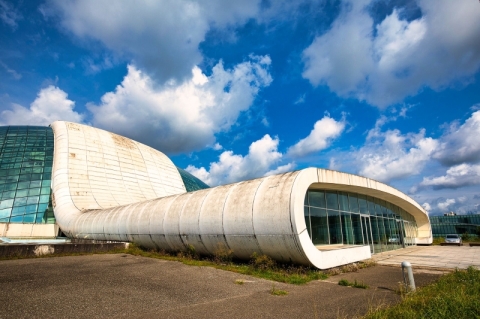Reisen
Georgian Parliament Building in Kutaisi
Former Parliament Building

Georgian Parliament Building in Kutaisi (Quelle: Roberto Magni Daniela Comi By Foto ReD Photographi)
GDN -
History and Construction
The Parliament Building in Kutaisi was built between 2011 and 2012, at the initiative of then President Mikheil Saakashvili. The decision to move the parliament from Tbilisi to Kutaisi was aimed at promoting the economic development of the region and decentralizing political power. The building was designed by the Spanish architectural firm CMD Ingenieros, with the collaboration of structural engineers such as Carlos Lázaro Fernández and other internationally renowned designers.
The Parliament Building in Kutaisi was built between 2011 and 2012, at the initiative of then President Mikheil Saakashvili. The decision to move the parliament from Tbilisi to Kutaisi was aimed at promoting the economic development of the region and decentralizing political power. The building was designed by the Spanish architectural firm CMD Ingenieros, with the collaboration of structural engineers such as Carlos Lázaro Fernández and other internationally renowned designers.
Architecture
The building is characterized by a large glass and steel dome, 100 meters long and 150 meters wide, which dominates the exterior. This oval structure is supported by a concrete element that serves as a roof, creating an imposing and futuristic visual effect. The total area of the building is approximately 40,000 square meters.
The building is characterized by a large glass and steel dome, 100 meters long and 150 meters wide, which dominates the exterior. This oval structure is supported by a concrete element that serves as a roof, creating an imposing and futuristic visual effect. The total area of the building is approximately 40,000 square meters.
Controversies and Criticism
The construction of the building was not without controversy. The site chosen for the building was previously occupied by the Memorial of Glory, a monument dedicated to Soviet soldiers of World War II. The demolition of the memorial in 2009, which was carried out using explosives, resulted in the accidental death of two people, a mother and her daughter. This event sparked much criticism and controversy.
Furthermore, the decision to move the parliament to Kutaisi was seen by some as inefficient, as the rest of the government remained in Tbilisi. Despite promises of economic development for Kutaisi, many considered the building an unnecessary waste of resources.
Function and Use
The parliament began its activities in Kutaisi in May 2012, but this situation lasted only until January 2019, when all parliamentary activities were moved back to Tbilisi. The decision to move the parliament back to the capital was made by the Georgian Dream coalition government, which amended the constitution in 2017 to remove any reference to Kutaisi as the seat of parliament.
Future of the Building
After the parliament moved to Tbilisi, the Kutaisi building is set to be taken over by the Georgian Ministry of Internal Affairs. The future use of the building remains uncertain, but it could be repurposed for other government or public purposes.
Conclusion
The Parliament Building in Kutaisi represents an interesting and complex chapter in Georgia’s recent history. A symbol of political ambition and regional development, the building is also an example of how architectural and urban planning decisions can have profound social and political implications.
Today, the Georgian Parliament Building in Kutaisi no longer hosts parliamentary activities, which were moved back to Tbilisi in January 2019. Currently, the building is abandoned but is set to be taken over by the Georgian Ministry of Internal Affairs. The specific future use of the building has not yet been fully defined, but it could be repurposed for other government or public purposes.
weitere Informationen: https://www.redmagazine.red
Für den Artikel ist der Verfasser verantwortlich, dem auch das Urheberrecht obliegt. Redaktionelle Inhalte von GDN können auf anderen Webseiten zitiert werden, wenn das Zitat maximal 5% des Gesamt-Textes ausmacht, als solches gekennzeichnet ist und die Quelle benannt (verlinkt) wird.







